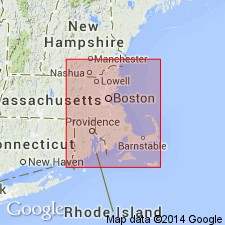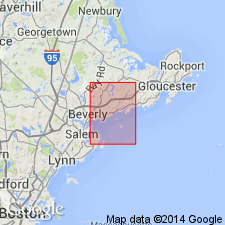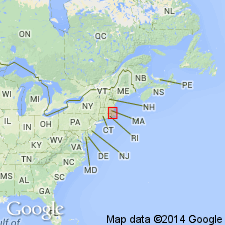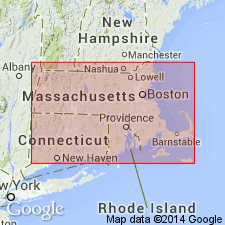
- Usage in publication:
-
- Squam Granite*
- Modifications:
-
- Age modified
- Revised
- AAPG geologic province:
-
- New England province
Summary:
Squam Granite is facies of Cape Ann Complex (revised) and is thus assigned an age of Late Ordovician or Early Silurian.
Source: GNU records (USGS DDS-6; Reston GNULEX).

- Usage in publication:
-
- Squam Granite*
- Modifications:
-
- Overview
- AAPG geologic province:
-
- New England province
Summary:
Used as Late Ordovician or Early Silurian Squam Granite of Cape Ann Complex. Consists of fine- to medium-grained monzodiorite.
Source: GNU records (USGS DDS-6; Reston GNULEX).

- Usage in publication:
-
- Squam Granite
- Modifications:
-
- Not used
- AAPG geologic province:
-
- New England province
Summary:
Cape Ann Complex of Goldsmith and others (1982) and as used on the Massachusetts State Geologic Map (Zen and others, 1983) is revised and renamed the Cape Ann Granite. The name is changed primarily because this rock assemblage does not fit the definition of a complex as defined in the North American Stratigraphic Code (1983). The new definition includes the original Cape Ann Granite (Toulmin, 1964) and the Beverly Syenite of Washington (1898, 1899) and Clapp (1910). The use of Cape Ann Complex, which includes the original Cape Ann Granite, the Squam Granite of Clapp (1910), and the Beverly Syenite, is discontinued. The Beverly Syenite is considered a facies of the Cape Ann Granite and effectively abandoned as a formal unit. [Squam not abandoned in this report.]
Source: GNU records (USGS DDS-6; Reston GNULEX).

- Usage in publication:
-
- Squam Granite*
- Modifications:
-
- Overview
- AAPG geologic province:
-
- New England province
Summary:
Squam Granite of Cape Ann Complex described as gray, brown weathering, fine to medium grained, with texture ranging from aplitic to porphyritic. Covers an area of 5 sq km within Cape Ann Complex, plus smaller masses elsewhere in the Cape Ann. [Papers presented as chapters in U.S. Geological Survey Professional Paper 1366 are intended as explanations and (or) revisions to MA State bedrock geologic map of Zen and others (1983) at scale of 1:250,000.]
Source: GNU records (USGS DDS-6; Reston GNULEX).

- Usage in publication:
-
- Squam Granite
- Modifications:
-
- Overview
- AAPG geologic province:
-
- New England province
Summary:
Squam Granite, though included in the Cape Ann Complex of this report, is probably not genetically related to the Cape Ann Granite and the Beverly Syenite, the dominant lithological types of the Complex. The origin of the granitic melt of the Cape Ann was likely under water-deficient conditions, but the origin of the Squam Granite, described here as a two-feldspar ferrohornblende biotite granite, remains obscure.
Source: GNU records (USGS DDS-6; Reston GNULEX).
For more information, please contact Nancy Stamm, Geologic Names Committee Secretary.
Asterisk (*) indicates published by U.S. Geological Survey authors.
"No current usage" (†) implies that a name has been abandoned or has fallen into disuse. Former usage and, if known, replacement name given in parentheses ( ).
Slash (/) indicates name conflicts with nomenclatural guidelines (CSN, 1933; ACSN, 1961, 1970; NACSN, 1983, 2005, 2021). May be explained within brackets ([ ]).

